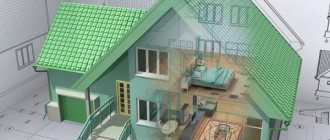Unauthorized construction was carried out on an unauthorized land plot
The Code stipulates that the only possible consequence of unauthorized construction on an unauthorized site is the demolition of the erected structure.
The decision on demolition is made by the local executive committee. The decision should also provide for imposing on the guilty person the obligation to return the unauthorized occupied land plot, which must be brought into a state suitable for use for its intended purpose, in the manner prescribed by the legislation on the protection and use of land.
As already mentioned in the first part of the article, there are not so many cases of construction on a land plot in the absence of any documents for it.
There was a precedent in the agency when, upon reviewing the documentation available to a potential seller of a residential building (the house had not yet been put into operation), it turned out that the building was built on a neighboring plot of land.
The construction sites are “cut” in an open field; indeed, it is not surprising to confuse them. This happened quite a long time ago; for the neighbor there was no fundamental difference (the plots were identical in size) - everything was settled through an “exchange” of land plots (counter purchase and sale agreements were concluded). If the owner of the neighboring plot did not want to “change”, then the building would either have to be demolished or “donated” to the neighbor.
In practice, most often there is a “spread” of a building beyond the boundaries of the site during construction or reconstruction. This is usually discovered already at the stage of drawing up technical documentation for erected (reconstructed) buildings. A specialist from the state registration agency (formerly BTI), while taking measurements on the ground to prepare a statement of technical characteristics, is able to use instruments to establish the location of the boundaries of the site in strict accordance with the land cadastral documentation.
In the first part of the article, a case was mentioned when the building of a utility block with a garage was located with a “spade” on the neighboring plot, which prevented the registration of conservation of the box of a residential building - ultimately, the conflict was resolved through the demolition of this building by its owner. And there was no other option, despite the fact that the neighboring plot of land belonged to a relative, and they could agree among themselves.
The solution could have been to change the “route” of the boundary between the plots, which would have allowed the issue to be resolved without dismantling the utility block, but the local executive committee refused to make such a decision for the simple reason that the legislation does not allow changing the boundaries of the plot if the fact of unauthorized construction is established on an unauthorized plot plot of land.
In another case, due to the fault of the builders, a bathhouse on a personal plot in one of the suburban villages was built with a partial offset beyond the border of the plot (it overlooked the “free” land of the village council). And this time the village executive committee refused to change the boundaries of the site, motivating the refusal by the presence of “AWOL”. As a result, the bathhouse, which is a log house the size of a small house, had to be moved several meters deep into the site, while additional work was carried out to dismantle part of the capital foundation protruding beyond the border of the land plot.
A simple conclusion suggests itself - when determining the location of a permanent structure on a plot of land before starting construction work, it is best to follow the well-known rule - “measure twice, cut once.”
Any construction and reconstruction must be carried out in compliance with urban planning standards. It is not easy to legalize unauthorized reconstruction even in court. The presence of violations during unauthorized construction may be grounds for refusal to satisfy a claim for recognition of ownership of the building.
Such unauthorized reconstruction can lead to serious negative consequences. The court may order the demolition of an extension if it was built in violation of legal requirements requiring the construction of utility buildings with an indentation of at least one meter from the border of the adjacent land plot. Please note that the reconstruction of a residential building is subject to the construction notification procedure. Before the start of reconstruction of a residential building, it is necessary to send a notice of planned construction to the local government body, and upon completion of construction - a notice of completion of construction. Construction (reconstruction) can begin only after receiving a notification from the administration about the compliance of the object with the established parameters and the admissibility of its placement on the land plot. Such documents will subsequently be necessary for cadastral registration and registration of rights to the reconstructed object. Unauthorized construction is a building, structure or other structure erected or created on a land plot that was not provided in the prescribed manner, or on a land plot whose permitted use does not allow the construction of this object on it, or erected or created without receiving the necessary funds for this. the force of law of approvals, permits or in violation of town planning and construction norms and rules, if the permitted use of the land plot, the requirement to obtain the appropriate approvals, permits and (or) the specified norms and rules are established on the date of the start of construction or creation of an unauthorized structure and are valid on the date identifying this building. Unauthorized buildings include an extension to a private residential building, erected without the necessary approval from the authorized body. Unauthorized buildings must be demolished or brought into compliance with established requirements, unless they are recognized as legal. The right of ownership of an unauthorized construction can be recognized, including in court. To recognize the right of ownership of an unauthorized structure in court, it is necessary to carry out the following actions: 1. determine whether you have the right to demand recognition of the right of ownership of an unauthorized building. This right has the owner of the land plot where the construction was carried out, as well as the person to whom the plot was granted by right lifelong inheritable possession or the right of permanent (perpetual) use, while simultaneously meeting the following conditions: - if in relation to the land plot the person who carried out the construction has rights allowing the construction of this object on it; - if on the day of going to court the building meets the established requirements; - if the preservation of the building does not violate the rights and legally protected interests of other persons and does not create a threat to the life and health of citizens. 2. draw up a statement of claim for recognition of ownership of an unauthorized construction. The statement of claim must indicate the type of your right to the land plot on which the unauthorized construction is located, the type of construction, as well as the person who carried it out (you or another person). Justify why the construction is unauthorized. For example, the necessary permissions have not been obtained. In the statement of claim, it must be noted that during the construction of the building there were no significant violations of town planning and construction norms and rules, that the building does not pose a threat to the life and health of citizens, and also does not violate the rights and legally protected interests of other persons. If you erected the unauthorized construction yourself, indicate whether you took measures to legalize it. For example, they applied for a construction permit, an act of putting the facility into operation. If the authorized body refused to provide you with such documents, indicate this circumstance. If an unauthorized building is erected by another person on a plot of land that belongs to you, the person who carried out the unauthorized construction is named as a defendant in the claim. If you built it, the defendant in the claim must indicate the local government body on whose territory the unauthorized construction is located. For example, the administration of a municipality. 3. The following documents must be attached to the statement of claim: - documents confirming ownership or other rights to the land plot. For example, the right of lifelong inheritable ownership, the right of permanent use; - documents confirming the presence of unauthorized construction on the site - inspection report, documents from the BTI; - documents that confirm that during the construction of the building there were no significant violations of town planning and construction norms and rules, that the building does not pose a threat to the life and health of citizens, and does not violate the rights and legally protected interests of other persons. These may include conclusions, inspection reports of authorized government bodies for architectural and construction (department of architecture and urban planning), fire (Ministry of Emergency Situations) and sanitary (SES) supervision; - documents that confirm your application to the authorized bodies for documents for unauthorized construction, for example, for a building permit; the results of consideration of your requests if you tried to legalize the construction, for example, refusal to issue a building permit; — notification of delivery or other documents confirming the sending to other persons participating in the case, copies of the statement of claim and documents attached to it that they do not have, including in the case of filing a statement of claim in electronic form; - documents confirming that the party (parties) have taken actions aimed at reconciliation, if such actions have been taken and the relevant documents are available; - a document confirming the payment of the state duty in the established manner and amount, or a document confirming the right to receive benefits for its payment, or a petition for a deferment, installment plan, a reduction in the amount of the state duty or an exemption from its payment; — power of attorney for a representative (if a representative will act on your behalf in court). 4. file a claim in court. The claim is sent to the magistrate at the location of the building if the cost of the unauthorized construction is no more than 50,000 rubles, and in other cases - to the district court. At the end of the consideration of the case, you will receive a court decision recognizing the right of ownership of the unauthorized construction or denying it. If the ownership of the building is recognized as yours, but another person erected it, then the court decision may provide for your obligation to compensate the person who built the unauthorized structure for the costs of its construction in the amount determined by the court. 5. To carry out state registration, the following documents will be required: - application for state registration; — document proving the identity of the applicant; — a document confirming the authority of your representative (if your representative is making the application); — a court decision recognizing ownership of an unauthorized construction. For state registration of rights to real estate, you must pay a state fee. The completed state registration of rights to real estate is certified by an extract from the Unified State Register of Real Estate, which can be sent to you electronically.
Administrative responsibility for unauthorized construction
And finally, I consider it necessary to remind you of another possible unpleasant consequence of unauthorized construction.
We are talking about article 21.12. Code of Administrative Offenses of the Republic of Belarus, which provides for liability for the unauthorized construction of residential buildings, industrial, economic, cultural, community or other buildings and structures in the form of a fine for an individual in the amount of twenty to fifty basic units, for an individual entrepreneur - from twenty to one hundred basic units, and for a legal entity - up to five hundred basic units.
A person who has carried out unauthorized construction may be brought to administrative responsibility no later than three years from the date of commission and six months from the date of discovery of unauthorized construction.
Officials are authorized to draw up protocols on administrative offenses under the article “unauthorized construction”:
- • rural, town, district, city and regional executive committees, district administrations in cities;
- • organizations operating the housing stock and (or) providing utility services;
- • bodies exercising state construction supervision;
- • bodies of the State Control Committee of the Republic of Belarus.
An administrative case regarding this offense is subject to consideration by a single judge of a district (city) court or an official of the State Control Committee of the Republic of Belarus in the case where the protocol on the commission of an administrative offense was also drawn up by an employee of this body.
New rights of local authorities.
They are spelled out in the new paragraph 4 of Art. 222 of the Civil Code of the Russian Federation. So, local government bodies of a city district (municipal district - if an unauthorized building is located on an intersettlement territory) have the right to make a decision on the demolition of an unauthorized building if it is created or erected on a land plot that is not provided in the prescribed manner for these purposes, if this plot is located:
- in a zone with special conditions for the use of territories (with the exception of the zone of protection of cultural heritage sites (historical and cultural monuments) of the peoples of the Russian Federation);
- in public areas;
- in the right of way of utility networks of federal, regional or local significance.
Within seven days from the date of the decision to demolish the unauthorized structure, a copy of such a decision must be sent to the person who carried out the unauthorized construction, indicating the period for demolition of the unauthorized structure (set taking into account the nature of the unauthorized construction, but cannot be more than 12 months).
If the specified person is not identified, the body that made the decision on demolition must publish, place on the Internet on the official website of the authorized local government body and on an information board within the boundaries of the land plot on which the unauthorized building was created, a message about the planned demolition of the unauthorized building. Under these circumstances, the demolition of an unauthorized building can be organized by the body that made the relevant decision no earlier than two months after the day the message was posted on the Internet.
A. G. Snegirev expert of the magazine “Public Catering Enterprises: Accounting and Taxation”, No. 8, August, 2015








